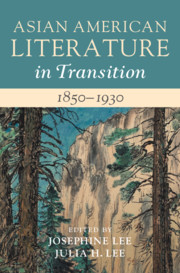Book contents
- Asian American Literature in Transition, 1850–1930
- Asian American Literature in Transition
- Asian American Literature in Transition, 1850–1930
- Copyright page
- Contents
- Illustrations
- Notes on Contributors
- Series Preface
- Introduction: Asian American Literature in Transition, 1850–1930
- Part I Empire and Resistance
- Chapter 1 Reframing Colonial Fantasy and Benevolent Violence
- Chapter 2 Uncollected
- Chapter 3 South Asian American Anti-colonial Writings
- Chapter 4 Challenging Enactments of Power
- Chapter 5 Saum Song Bo on the Statue of Liberty
- Chapter 6 Island in Between
- Part II Bodies at Work and Play
- Part III Crossings
- Bibliography
- Index
Chapter 5 - Saum Song Bo on the Statue of Liberty
A Protest against US Chinese Exclusion and French Imperialism
from Part I - Empire and Resistance
Published online by Cambridge University Press: 27 May 2021
- Asian American Literature in Transition, 1850–1930
- Asian American Literature in Transition
- Asian American Literature in Transition, 1850–1930
- Copyright page
- Contents
- Illustrations
- Notes on Contributors
- Series Preface
- Introduction: Asian American Literature in Transition, 1850–1930
- Part I Empire and Resistance
- Chapter 1 Reframing Colonial Fantasy and Benevolent Violence
- Chapter 2 Uncollected
- Chapter 3 South Asian American Anti-colonial Writings
- Chapter 4 Challenging Enactments of Power
- Chapter 5 Saum Song Bo on the Statue of Liberty
- Chapter 6 Island in Between
- Part II Bodies at Work and Play
- Part III Crossings
- Bibliography
- Index
Summary
Saum Song Bo, a Chinese man in the United States, published an open letter in 1885 to express consternation about being asked to donate to the construction of the Statue of Liberty’s pedestal.The solicitation came three years after the Chinese Exclusion Act.Saum was not subjected to exclusion himself, because he entered the United States as a student, an exempted class.Yet he was able to effect cross-class solidarities on the basis of the United States’ race-based immigration restrictions.Additionally, the Statue of Liberty was a gift from France to the United States, and France had imperial leverage over Vietnam.Saum’s letter effected a comparative condemnation of US and French inequities -exposing the ironies behind the vision of liberty the statue represents.This chapter argues that in bringing together US racism and French imperialism, Saum produced an early form of Asian Americanist critique most closely associated with movements that took place much later in the 1960s and 1970s.
Keywords
- Type
- Chapter
- Information
- Asian American Literature in Transition, 1850–1930 , pp. 88 - 101Publisher: Cambridge University PressPrint publication year: 2021

